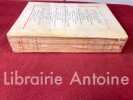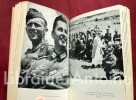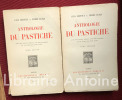22328 books for « leon t r p »Edit
-
Type
Artists book (3)
Autograph (4)
Book (21329)
Drawings (4)
Engraving (30)
Magazine (74)
Manuscript (11)
Maps (3)
Music sheets (808)
New book (1)
Old papers (5)
Photographs (54)
Posters (2)
-
Latest
Last 24h (4)
Last 3 days (10)
Last month (165)
Last week (26)
-
Language
Dutch (7)
English (14)
French (22237)
German (3)
Latin (1)
Russian (50)
Spanish (16)
-
Century
16th (16)
17th (9)
18th (30)
19th (2767)
20th (10145)
21st (413)
-
Countries
Belgium (1376)
Brazil (4)
Canada (102)
China (45)
Côte d'Ivoire (20)
Denmark (37)
France (19675)
Germany (59)
Greece (18)
Italy (25)
Switzerland (904)
United Kingdom (2)
United States of America (61)
-
Syndicate
ALAC (77)
CLAM (100)
CLAQ (40)
CNE (8)
ILAB (10667)
NVVA (139)
SLACES (139)
SLAM (10197)
SNCAO (103)
Topics
- Algeria (100)
- Archaeology (157)
- Architecture (116)
- Autographs (200)
- Belgium (149)
- Bibliophilism (90)
- Biography (350)
- Bloy léon (233)
- Blum léon (71)
- Brittany (131)
- Children’s books (92)
- China (79)
- Christianity (107)
- Cladel léon (62)
- Communism (69)
- Daudet léon (811)
- Dedication (117)
- Denis léon (95)
- Early printed books (96)
- Economics (115)
- Education (91)
- Emery léon (75)
- Fargue léon paul (145)
- Fine arts (175)
- First edition (519)
- Fox (84)
- Frapié léon (106)
- Genealogy (87)
- Geography (151)
- Gozlan léon (111)
- Groc léon (96)
- Helvética (78)
- History (1275)
- Homo léon (96)
- Humour anecdotes (64)
- Illustrated books (84)
- Industrial arts & crafts - fine arts (81)
- Journalism (76)
- Law (216)
- Lemonnier léon (101)
- Leon donna (116)
- Léon paul (428)
- Levrault léon (117)
- Literature (2245)
- Lorrain (69)
- Magazine (165)
- Manuscripts (78)
- Maurras charles (74)
- Medicine (215)
- Middle ages (64)
- Military arts (93)
- Navy (149)
- Newspapers press (297)
- Normandy (77)
- Painting (82)
- Paris (350)
- Philosophy (351)
- Photography (135)
- Poetry (353)
- Policy (235)
- Provence (86)
- Psychology (137)
- Raiter léon (201)
- Regionalism (205)
- Religions (285)
- Reliure (62)
- Review (270)
- Reviews (235)
- Robin (79)
- Rome (79)
- Russia (123)
- Sciences (108)
- Scores (714)
- Socialism (75)
- Sociology (67)
- Songs (632)
- Switzerland (106)
- Symbolism (66)
- Theatre (254)
- Theology (117)
- Tolstoi léon (392)
- Trade (118)
- Travel (93)
- Treich léon (78)
- Trotsky léon (319)
- Ussr (106)
- Various (107)
- War (340)
- Zitrone léon (104)
La Caution. Conte. Manuscrit et images de Léon Lebègue.
Paris Librairie des Amateurs. A. Ferroud 1912 In-8 (h. 23 cm.) xxviii-(2) pp. couverture conservée, demi-reliure à coins maroquin havane, dos à nerfs décoré de fleurons et d'un décor mosaïqué, tête dorée (reliure signée de Aussourd). Edition tirée à 350 exemplaires, celui-ci sur vélin. Illustrations gravées et coloriées au pochoir.
Reliure un peu frottée au mors, rares piqûres, quelques pages sont roussies par le report de la page opposée. Bon exemplaire cependant. Libraire membre du S.L.A.M. (Syndicat national de la Librairie Ancienne et Moderne) et de la L.I.L.A. (Ligue Internationale de la Librairie Ancienne). N'hésitez pas à prendre contact par mail pour des photographies et des détails supplémentaires, pour des recherches ou des estimations de livres anciens et rares.
Gavarni (Paul), Gautier (Théophile), Gozlan (Léon), Laurent-Jan (pseudonyme d'Alphonse Jean Laurent), Stahl (P.-J.) pseudonyme de Jules Hetzel.
Reference : 1277
Oeuvres choisies de Gavarni revues, corrigées et nouvellement classées par l'auteur. Etudes de moeurs contemporaines. Les Enfants terribles. - traduction en langue vulgaire. - Les Lorettes. Les Actrices. Avec des notices en tête de chaque série. par MM. Théophile Gauthier & Laurant-Jan. (1846) ; La Vie de jeune homme. - Les débardeurs. Avec des notices [...] de P.-J. Stahl. (1848) ; Le Carnaval à Paris. - Paris le matin. - Les Etudiants de Paris. Avec des notices […] par MM. Théophile Gautier, A. Barthet & A. de Soubiran. (1847) ; Fourberies de femmes en matière de sentiment. - Clichy. - Paris le soir. Avec des notices […] par MM. Laurent-Jan, Lireux & Léon Gozlan. (1846)
Paris J. Hetzel 1846-1848 4 tomes reliés en 2 volumes, plein chagrin vert, dos à nerfs, filets et fleurons (reliure de l’époque). Frontispice, vignette sur chaque page de titre et 319 planches hors-texte (une planche supplémentaire non annoncée dans la série des Enfants terribles, deux planches non reliées dans la série de Clichy.
Dos assombris, quelques épidermures légères (discrètes reprises de teinte), petites taches sur la moire des gardes, sinon pages blanches et sans rousseurs. Bel exemplaire. Références : Vicaire, III, 953-955 ; Brivois pp.168-171 ; Carteret, III-260-264. Libraire membre du S.L.A.M. (Syndicat national de la Librairie Ancienne et Moderne) et de la L.I.L.A. (Ligue Internationale de la Librairie Ancienne). N'hésitez pas à prendre contact par mail pour des photographies et des détails supplémentaires, pour des recherches ou des estimations de livres anciens et rares.
Le Corbeau.
2013 Dessin original à l'encre de chine (20 x 13 cm.), signé à la plume sur vélin teinté (29,9 x 23,2 cm.). Dans la marge inférieure, texte manuscrit tiré du Corbeau d'Edgar Poe, traduit par Mallarmé : "Que ce mot soit le signal de notre séparation, oiseau ou malin esprit, hurlai-je en me dressant".
Lev Vassilievitch Zack, dit « Léon Zack », est un peintre russe, naturalisé français en 1938, né le 12 juillet 1892 à Nijni Novgorod et mort à Vanves (Hauts-de-Seine) le 30 mars 1980. Libraire membre du S.L.A.M. (Syndicat national de la Librairie Ancienne et Moderne) et de la L.I.L.A. (Ligue Internationale de la Librairie Ancienne). N'hésitez pas à prendre contact par mail pour des photographies et des détails supplémentaires, pour des recherches ou des estimations de livres anciens et rares.
Sous le signe de Don Quichotte. Catalogue Nicolas. Liste des grands vins fins 1953. Illustrations de Léon Gischia. Ornements d'Afred Latour.
Paris Draeger 1952 In-8 carré, reliure spirale plastique,couverture cartonnée. Nombreuses illustrations au pochoir. Complet de la feuille volante des tarifs.
Superbe exemplaire d'un des plus beaux catalogues de la maison Nicolas. "Ces catalogues sont adressés à une liste des clients potentiels rigoureusement triés et qui compte environ 30 000 noms, choisis parmi les clients dont Nicolas possède le nom : professions libérales, Bottin mondain, Jockey Club, etc. Il n'est pas exagéré de dire que ces catalogues sont des petits chefs-d'oeuvre de l'art de l'illustration. Ils sont l'oeuvre, depuis le début, de l'atelier Draeger. Nicolas en demande toujours l'illustration à un peintre ou à un graveur de renom. Rien ne le fait reculer. C'est ainsi qu'au cours des années Van Dongen, Bernard Buffet, Raoul Dufy ont signé des catalogues Nicolas. La collection de ces catalogues est aujourd'hui une des choses prisées des bibliophiles. D'abord, il en existe relativement peu. Ensuite, leur diffusion limitée, strictement, à titre gratuit, à un certain nombre de personnes sélectionnées sur liste, confère au cercle de ses possesseurs un caractère de « club fermé », ce qui augmente encore leur valeur. Nicolas avait à résoudre, avec ses catalogues, un double problème. D'abord, faire en sorte que les plus grands artistes contemporains ne se sentent pas diminués de mettre leur palette au service de ce qui n'est — après tout — qu'une affaire de produits alimentaires. Ensuite, enlever à Nicolas, aux yeux des classes riches, ce que la multiplication des dépôts pourrait donner de caractère « trop bon marché » : en somme, obtenir que du vin Nicolas figure dans les grands dîners parisiens. […] Quelquefois, lors de la dispersion d'une bibliothèque, dans une vente aux enchères, à l'occasion d'une succession, on offre, dans des paniers anonymes, en vrac, les brochures, catalogues d'exposition (quelquefois vraiment fort beaux) que le propriétaire avait collectionnés. Les catalogues Nicolas sont, eux, souvent conservés dans l'ensemble de la bibliothèque et inscrits au catalogue, comme les éditions rares et originales. N'est-ce pas une belle fin pour une publicité ?" (Claude Vielfaure. Une monographie publicitaire : Nicolas) Libraire membre du S.L.A.M. (Syndicat national de la Librairie Ancienne et Moderne) et de la L.I.L.A. (Ligue Internationale de la Librairie Ancienne). N'hésitez pas à prendre contact par mail pour des photographies et des détails supplémentaires, pour des recherches ou des estimations de livres anciens et rares.
Les mondes nordiques. Figures et survivances de l'Europe barbare. Préface et postface pour l'édition française par Léon Fleurot professeur à l'université Rennes II, directeur à l'Ecole Pratique des Hautes Etudes.
Paris Librairie Jules Tallandier 1980 In-4 (h. 30 cm.) 248 pp. reliure cartonnée, jaquette.
Bon état (petite marque à la couverture). Libraire membre du S.L.A.M. (Syndicat national de la Librairie Ancienne et Moderne) et de la L.I.L.A. (Ligue Internationale de la Librairie Ancienne). N'hésitez pas à prendre contact par mail pour des photographies et des détails supplémentaires, pour des recherches ou des estimations de livres anciens et rares.
La Lutte française pour exercices d'ensemble
Paris La Société des Athlètes français (1892) In-12 (15,5 x 12,5 cm.) 31 pp. non rogné, tête rougie, demi-reliure maroquin rouge à coins (reliure signée V. Wynants).
Exemplaire imprimé sur papier vergé et édicacé par l'auteur, président de la Société des athlètes français. Libraire membre du S.L.A.M. (Syndicat national de la Librairie Ancienne et Moderne) et de la L.I.L.A. (Ligue Internationale de la Librairie Ancienne). N'hésitez pas à prendre contact par mail pour des photographies et des détails supplémentaires, pour des recherches ou des estimations de livres anciens et rares.
Le Pays et le vin Beaujolais, suivi d'une anthologie bachique, précédé d'un souvenir par Henri Béraud. Préface de Justin Godart.
Villefrance-en-Beaujolais chez Jean Guillermet 1929 In-8 (23 x 15 cm.) 199 pp. demi-reliure basane fauve, dos à nerfs. Une carte repliée en fin de volume. Frontispice de Ph. Burnot. Dessins de J. Limonon. nombreuses planches photographiques.
Tirage de luxe à 200 exemplaires numérotés, celui-ci est un des 190 sur papier à la forme de Montgolfier. Bel exemplaire relié, portant l'ex-libris de l'auteur, qui l'a offert en 1959 à un ami en y ajoutant un envoi. Libraire membre du S.L.A.M. (Syndicat national de la Librairie Ancienne et Moderne) et de la L.I.L.A. (Ligue Internationale de la Librairie Ancienne). N'hésitez pas à prendre contact par mail pour des photographies et des détails supplémentaires, pour des recherches ou des estimations de livres anciens et rares.
Les Ruelles du XVIII° siècle. Préface par Alexandre Dumas fils. Eaux-fortes par Mongin.
Paris Edouard Rouveyre 1879 Deux volumes in-8 (h. 20 cm.) xxii et 534, 566 pp. demi-reliure à coins maroquin chocolat. Tirage à 600 exemplaires numérotés, celui-ci est un des 500 sur vergé de Hollande.
Bon exemplaire. Infimes marques à la reliure. Libraire membre du S.L.A.M. (Syndicat national de la Librairie Ancienne et Moderne) et de la L.I.L.A. (Ligue Internationale de la Librairie Ancienne). N'hésitez pas à prendre contact par mail pour des photographies et des détails supplémentaires, pour des recherches ou des estimations de livres anciens et rares.
Le vin de nos vignes. Souvenirs et pages d'autrefois. Préface de André Latreille Illustrations de Luc Barbier.
Villefranche-sur-Saone Editions du Cuvier 1950 In-8 (21 x 16 cm.) 127 pp. broché, non rogné, photographies et dessins hors-texte.
Edition limitée à 800 exemplaires, celui-ci est un des 35 numérotés sur pur fil de Lana. Dédicace de l'auteur sur la page de garde. Bon exemplaire. Libraire membre du S.L.A.M. (Syndicat national de la Librairie Ancienne et Moderne) et de la L.I.L.A. (Ligue Internationale de la Librairie Ancienne). N'hésitez pas à prendre contact par mail pour des photographies et des détails supplémentaires, pour des recherches ou des estimations de livres anciens et rares.
La jeunesse dorée sous Louis-Philippe. Alfred de Musset de Musard à la reine Pomaré. La Présidente. (documents indédits. Portraits d'Alfred Tattet, Alfred de Musset, Arvers, M. et Mme Guttinguer, la reine Pomaré, la Présidente).
Paris Mercure de France 1910 In-8 (h. 23 cm.) 370 pp. couverture souple.
Exemplaire non coupé. Bon état. Libraire membre du S.L.A.M. (Syndicat national de la Librairie Ancienne et Moderne) et de la L.I.L.A. (Ligue Internationale de la Librairie Ancienne). N'hésitez pas à prendre contact par mail pour des photographies et des détails supplémentaires, pour des recherches ou des estimations de livres anciens et rares.
Lexique arabe-français suivi d'un index français-arabe. Contribution à l'étude de l'arabe moderne.
Tunis 1938 In-4 (h. 28 cm.) 350 pp. reliure cartonnée, dos toilé.
Bon exemplaire avec une reliure artisanale. Un feuillet un peu déboité, sinon bon état. Libraire membre du S.L.A.M. (Syndicat national de la Librairie Ancienne et Moderne) et de la L.I.L.A. (Ligue Internationale de la Librairie Ancienne). N'hésitez pas à prendre contact par mail pour des photographies et des détails supplémentaires, pour des recherches ou des estimations de livres anciens et rares.
Aucune trace. Roman.
Paris Gallimard 1963 In-12 (h. 18 cm.) 238 pp. broché.
Edition originale, exemplaire du service de presse. Petite étiquette de collection au dos. Bon état. Libraire membre du S.L.A.M. (Syndicat national de la Librairie Ancienne et Moderne) et de la L.I.L.A. (Ligue Internationale de la Librairie Ancienne). N'hésitez pas à prendre contact par mail pour des photographies et des détails supplémentaires, pour des recherches ou des estimations de livres anciens et rares.
La modalité du jugement. Deuxième édition. Bibliothèque de philosophie contemporaine.
Paris Felix Alcan 1934 In-8 (h. 22,5 cm.) 246 pp. couverture souple.
Bon exemplaire marlgé un petit accroc en haut du dos et quelques très rares marques de lecture (une vingtaine de lignes soulignées). Libraire membre du S.L.A.M. (Syndicat national de la Librairie Ancienne et Moderne) et de la L.I.L.A. (Ligue Internationale de la Librairie Ancienne). N'hésitez pas à prendre contact par mail pour des photographies et des détails supplémentaires, pour des recherches ou des estimations de livres anciens et rares.
[NICOLAS]. EDY LEGRAND (pseudonyme de Édouard Léon Louis Warschawsky)
Reference : 3767
(1932)
Catalogue Nicolas. Liste des grands vins 1932. Illustrations de Edy Legrand.
Paris Draeger 1932 In-8 carré, reliure spirale métallique,couverture cartonnée noire estampée d'un médaillon qui laisse voir un cortège de Bacchus sur la page de garde, Nectar fermant la marche. Nombreux bois gravés en noir dans les marges et plusieurs grandes compositions hors-texte en couleurs (dont deux pleines pages) d'une grande fraîcheur de couleurs et d'une grande fantaisie.
Très bel exemplaire de ce rare catalogue illustré par un des grands artistes de l'époque, connu d'abord pour ses dessins publicitaires et ses illustrations littéraires, plus tard pour sa peinture orientaliste."Ces catalogues sont adressés à une liste des clients potentiels rigoureusement triés et qui compte environ 30 000 noms, choisis parmi les clients dont Nicolas possède le nom : professions libérales, Bottin mondain, Jockey Club, etc. Il n'est pas exagéré de dire que ces catalogues sont des petits chefs-d'oeuvre de l'art de l'illustration. Ils sont l'oeuvre, depuis le début, de l'atelier Draeger. Nicolas en demande toujours l'illustration à un peintre ou à un graveur de renom. Rien ne le fait reculer. C'est ainsi qu'au cours des années Van Dongen, Bernard Buffet, Raoul Dufy ont signé des catalogues Nicolas. La collection de ces catalogues est aujourd'hui une des choses prisées des bibliophiles. D'abord, il en existe relativement peu. Ensuite, leur diffusion limitée, strictement, à titre gratuit, à un certain nombre de personnes sélectionnées sur liste, confère au cercle de ses possesseurs un caractère de « club fermé », ce qui augmente encore leur valeur. Nicolas avait à résoudre, avec ses catalogues, un double problème. D'abord, faire en sorte que les plus grands artistes contemporains ne se sentent pas diminués de mettre leur palette au service de ce qui n'est — après tout — qu'une affaire de produits alimentaires. Ensuite, enlever à Nicolas, aux yeux des classes riches, ce que la multiplication des dépôts pourrait donner de caractère « trop bon marché » : en somme, obtenir que du vin Nicolas figure dans les grands dîners parisiens. […] Quelquefois, lors de la dispersion d'une bibliothèque, dans une vente aux enchères, à l'occasion d'une succession, on offre, dans des paniers anonymes, en vrac, les brochures, catalogues d'exposition (quelquefois vraiment fort beaux) que le propriétaire avait collectionnés. Les catalogues Nicolas sont, eux, souvent conservés dans l'ensemble de la bibliothèque et inscrits au catalogue, comme les éditions rares et originales. N'est-ce pas une belle fin pour une publicité ?" (Claude Vielfaure. Une monographie publicitaire : Nicolas) Libraire membre du S.L.A.M. (Syndicat national de la Librairie Ancienne et Moderne) et de la L.I.L.A. (Ligue Internationale de la Librairie Ancienne). N'hésitez pas à prendre contact par mail pour des photographies et des détails supplémentaires, pour des recherches ou des estimations de livres anciens et rares.
La Campagne de Russie 1941-1945
Paris La Diffusion du Livre - Le Cheval Ailé 1949 In-12 (h. 19 cm.) 501 pp; broché, couverture noire et rouge.
Papier jauni, petites pliures et manques à la couverture, bon état général. Libraire membre du S.L.A.M. (Syndicat national de la Librairie Ancienne et Moderne) et de la L.I.L.A. (Ligue Internationale de la Librairie Ancienne). N'hésitez pas à prendre contact par mail pour des photographies et des détails supplémentaires, pour des recherches ou des estimations de livres anciens et rares.
Face à face avec le rexisme.
De Schorpioen / Le Scorpion 1971 In-8 (h. 22 cm.) 158 pp. couverture souple. Nombreuses photographies hors-texte.
Bon état. Libraire membre du S.L.A.M. (Syndicat national de la Librairie Ancienne et Moderne) et de la L.I.L.A. (Ligue Internationale de la Librairie Ancienne). N'hésitez pas à prendre contact par mail pour des photographies et des détails supplémentaires, pour des recherches ou des estimations de livres anciens et rares.
La cohue de 40. Récit d'un effondrement.
Paris Avalon 1991 Grand in-8 (h. 25cm.) 523 pp. couverture cartonnée rouge.
Très bon état. Libraire membre du S.L.A.M. (Syndicat national de la Librairie Ancienne et Moderne) et de la L.I.L.A. (Ligue Internationale de la Librairie Ancienne). N'hésitez pas à prendre contact par mail pour des photographies et des détails supplémentaires, pour des recherches ou des estimations de livres anciens et rares.
La Chèvre de Pescadoire.
Paris Bernard Grasset 1911 In-12 (19 x 12,5 cm.) 252 pp. demi-reliure fauve, dos décoré de filets à froid et d'incrustation de cuir vert.
Bel exemplaire soigneusement relié. Libraire membre du S.L.A.M. (Syndicat national de la Librairie Ancienne et Moderne) et de la L.I.L.A. (Ligue Internationale de la Librairie Ancienne). N'hésitez pas à prendre contact par mail pour des photographies et des détails supplémentaires, pour des recherches ou des estimations de livres anciens et rares.
Anthologie du pastiche avec des textes inédits, une bibliographie et un index des noms cités.
Paris Editions G. Crès et Cie 1926 Deux volumes in-12 (19 x 12 cm.) 233 et 229 pp. brochés.
Papier jauni, petites déchirures à la pliure. Libraire membre du S.L.A.M. (Syndicat national de la Librairie Ancienne et Moderne) et de la L.I.L.A. (Ligue Internationale de la Librairie Ancienne). N'hésitez pas à prendre contact par mail pour des photographies et des détails supplémentaires, pour des recherches ou des estimations de livres anciens et rares.
Chronique de l'Académie Goncourt.
Paris Firmin-Didot 1929 In-8 (19,5 x 14 cm.) 230 pp. broché. Avec de nombreuses illustrations dans le texte et 12 planches hors-textes (fac-simile, photographies, etc..
Edition originale du tirage courant. Bel exemplaire non coupé. Libraire membre du S.L.A.M. (Syndicat national de la Librairie Ancienne et Moderne) et de la L.I.L.A. (Ligue Internationale de la Librairie Ancienne). N'hésitez pas à prendre contact par mail pour des photographies et des détails supplémentaires, pour des recherches ou des estimations de livres anciens et rares.
Composite. Débats, idées bohémiennes, anecdotes. Gravures de Galanis.
Paris Ocia 1944 In-4, 108 pp, en feuilles sous couverture blanche imprimée. Belle gravure au burin sur double page, signée dans la planche, vignettes gravées sur bois. Petites salissures et usures sans gravité à la couverture.
Edition tirée à 350 exemplaires numérotés, celui-ci sur simili-japon, troisième papier. Infimes marques à la couverture. Libraire membre du S.L.A.M. (Syndicat national de la Librairie Ancienne et Moderne) et de la L.I.L.A. (Ligue Internationale de la Librairie Ancienne). N'hésitez pas à prendre contact par mail pour des photographies et des détails supplémentaires, pour des recherches ou des estimations de livres anciens et rares.
Léon Brillouin 1889-1969 - A la croisée des ondes , (Mécanique quantique et physique du solide - Théorie des ondes et théorie de l'information)
Belin , Un Savant, une Epoque Malicorne sur Sarthe, 72, Pays de la Loire, France 1999 Book condition, Etat : Bon broché, sous couverture imprimée éditeur blanche, illustrée d'un portrait de Léon Brillouin en vignette rouge In-8 1 vol. - 255 pages
quelques illustrations dans le texte en noir et blanc 1ere édition, 1999 Contents, Chapitres : Avant-propos - Une tradition familiale (Eleuthère Mascart et Marcel Brillouin) - Etudes et thèse (Propagation des ondes en milieu dispersif - Les tenseurs en mécanique et en électricité) - Du bleu du ciel à l'effet Brillouin (L'interaction de la lumi-re avec un solide - Effets Brillouin et Raman) - La nouvelle mécanique (A la frontière des mondes classique et quantique, la méthode Brillouin, Wentzel, Kramers - La diffraction d'ondes électromagnétiques par une sphère - Paramagnétisme et fonctions de Brillouin - Les statistiques quantiques) - Les zones de Brillouin et la théorie des électrons dans les solides - De l'Institut Poincaré au Collège de France (Méthode perturbative de Brillouin-Wigner - Théorème de Brillouin) - Entre les ondes et l'information, directeur de la radiodiffusion nationale (Théorie du magnétron) - Démon de Maxwell et théorie de l'information (Entropie, concept nomade) - De nouveaux centres d'intérêt (Premier ordinateur français - Vie, matière et observations, systèmes dynamiques, théorème de Poincaré) - Epilogue - Références, chronologie, oeuvres de Léon Brillouin, index - Léon Nicolas Brillouin, né le 7 août 1889 à Sèvres1 et mort le 4 octobre 1969 à New York, est un physicien franco-américain, essentiellement connu pour ses travaux en mécanique quantique et en physique du solide. Il a notamment travaillé sur la théorie des ondes et la théorie de l'information. - Léon Brillouin entre à lÉcole normale supérieure en 1908. À la fin de sa scolarité, il décide de continuer ses études à lInstitut de physique théorique de Munich dont la direction était alors assumée par Arnold Sommerfeld. Il va y travailler au laboratoire de Max von Laue (1879-1960) sur la physique du solide, qui en était à ses premiers balbutiements. Il rentre en France en 1913 et commence une thèse sur « La théorie des solides et les quanta », quil ne pourra soutenir quen 1921 en raison de sa mobilisation, pendant la Première Guerre mondiale, dans les services de radiotélégraphie. Au cours de sa carrière scientifique, Léon Brillouin apportera à la science des contributions importantes, dont l'effet qui porte son nom, le concept de diffusion Brillouin, et les zones de Brillouin, pour ne citer que l'un des domaines, la physique des solides, où il a su exercer son talent, et qu'il a même contribué à fonder. En avril 1926, Léon Brillouin synthétisait dans le renommé Journal de physique près de dix articles publiés par des physiciens étrangers comme Werner Heisenberg, Max Born ou Pascual Jordan. Il a ainsi joué un rôle important dans lintroduction en France de la mécanique quantique. En 1927, il fut avec Marie Curie, Louis de Broglie, Émile Henriot et Paul Langevin l'un des cinq Français invités au cinquième congrès Solvay3,4, qui marqua la naissance officielle de la mécanique quantique. Il fut titulaire de la chaire de théories physiques à la faculté des sciences de l'université de Paris de 1928 à 1932 avant d'être élu au Collège de France, succédant à son père Marcel Brillouin. Louis de Broglie lui succéda à la Sorbonne. En août 1939, un mois avant la déclaration de guerre à lAllemagne, Léon Brillouin est nommé, en tant que spécialiste de la propagation des ondes, directeur de la Radiodiffusion nationale. Ayant exercé la fonction quelque temps pendant le régime de Vichy, il démissionne à la fin de 1940 et émigre aux États-Unis. Il y enseigne dans plusieurs universités (dont celle de Harvard) et travaille chez IBM de 1948 à 1954. Il est élu membre de l'académie des sciences américaine en 1953. Il terminera sa carrière et sa vie aux États-Unis. Il publie en 1959 Science et théorie de l'information (version anglaise en 1962) où sont examinées les relations entre ces deux disciplines. Il adopte notamment un point de vue de physicien et fait le lien entre l'entropie informationnelle de Shannon et l'entropie statistique de Boltzmann. Un certain nombre de jeux sur le contenu d'information des textes, dus à Shannon, se trouvent répertoriés dans cet ouvrage. Des concepteurs comme Walter Lewino utiliseront le concept pour la réalisation de jeux interactifs très voisins sur Minitel. (source : Wikipedia) infimes traces de pliures sur les plats de la couverture, sinon bon exemplaire, intérieur frais et propre, cela reste un bon exemplaire de la biographie de référence de Léon Brillouin, un immense physicien français, cette biographie de Rémy Mosseri est une des plus détaillée en langue française
L'ATLANTIDE : roman, par Pierre Benoit, illustrations en couleurs par Léon Carré
Paris H. Piazza 1939 -in-8 broché sous emboitage un fort volume, broché in-octavo (paperback in-octavo) (16,5 x 22,6 cm), sous couverture rempliée dans sont étui cartonné, dos et couverture crème imprimés en vert, couverture rempliée illustrée en couleurs par Léon CARRE (cover printed and illustrated), toutes tranches non rognées (all edges no smooth), Edition Numérotée, tirage limité à 1100 exemplaires, un des 900 Exemplaires sur papier Vélin de rives(N°287) avec suite en noir des illustrations de Léon CARRE sur Hollande Van Gelder, orné de nombreuse illustrations in et hors-texte en couleur par Léon CARRE, 271 pages + (3) f. (notes, table, justificatif de tirage), 1939 Paris l'Édition d'Art H. Piazza Editeur,
Pierre Benoit, né le 16 juillet 1886 à Albi (Tarn) et mort le 3 mars 1962 à Ciboure (Pyrénées-Atlantiques), est un écrivain français, membre de l'Académie française, dont les romans d'aventures, au premier rang desquels L'Atlantide, ont connu un succès considérable dans la première moitié du XXe siècle.........Léon Carré, né Léon Georges Jean-Baptiste Carré à Granville le 23 juin 1878, et mort à Alger le 2 décembre 1942, est un peintre et illustrateur français........Bel Exemplaire........en trés bon état (very good condition). en trés bon état
[PÉRIODIQUE SATIRIQUE]. GILL (Louis-Alexandre Gosset de Guines, dit André), [CHAMPSAUR (Félicien), VANIER (Léon)].
Reference : 240010
Les Hommes d'aujourd'hui.. Portraits-charge. Par A. Gille [et H. Demare]
Paris, A. Cinqualbre, s.d. (13 septembre 1878-1881) 206 fascicules en 4 vol. in-4, [2] ff. n. ch. (faux-titre et titre illustré d'une vignette en couleurs), puis ff. n. ch., brochés sous couvertures illustrées en couleurs. Déchirures à la livraison 101 (avec perte de texte).
Tête de collection de ce périodique satirique et propagandiste.La collection complète comprend 469 livraisons réunies en dix volumes, parus de 1878 à 1899.Chaque livraison de 4 pp. n. ch. comprend un texte généralement composé par Félicien Champsaur, ou Léon Vanier (sous le pseudonyme de Pierre et Paul), et, en première page, une grande caricature en couleurs de Gill, offrant une petite monographie mordante (mais pas trop) sur une personnalité contemporaine des arts, des lettres, et aussi du monde politique, du monde scientifique et technique ou de la religion (très rare dans ce dernier cas de figure), avec une prédilection des plus marquée pour les coryphées républicains et les auteurs anticléricaux, même les plus obscurs et les plus médiocres, à condition qu'ils soient bien fanatiques ... Conformément au titre, il s'agit presque uniquement de célébrités masculines françaises, à l'exception des livraisons 103 (Maria Deraismes), 118 (Juliette Lamber) et 170 (Clémence Royer), ainsi que de la 162 (Bradlaugh). Dans l'ensemble, on a ici un bon exemple des figures - plus ou moins mythologiques dans les biographies exposées - que les Républicains désiraient proposer à l'admiration, dans le but de changer les mentalités et l'esprit public au moment de l'installation du régime de la Troisième.La date figure en haut seulement à partir de la sixième livraison (18 octobre 1878), pour redisparaître à la vingt-cinquième.I. Premier volume : 1. Victor Hugo. - 2. Léon Cladel. - 3. Constant Coquelin. - 4. Émile Zola. - 5. Léon Gambetta. - 5. Aurélien Scholl. - 7. Sarah Bernhardt. - 8. Nadar. - 9. Auguste Vacquerie. - 10. André Gill. - 11. Émile de Girardin. - 12. 12. Victor Capoul. - 13. Louis Blanc. - 14. Paul de Cassagnac. - 15. Edmond About. - 16. Sophie Croizette. - 17. Grévin. - 18. Émile Littré. - 19. Francisque Sarcey. - 20. M. Bardoux. - 21. Olivier Métra. - 22. Challemel-Lacour. - 23. Alphonse Daudet. - 24. Giuseppe Garibaldi. - 25. Jules Grévy. - 26. Ernest Hamel. - 27. Charles Floquet. - 28. Saint-Genest. - 29. Édouard Lockroy. - 30. Georges Clemenceau. - 31. Hector Pessard. - 32. Charles Monselet. - 33. Le docteur Pajot. - 34. Arthur Ranc. - 35. Jules Claretie. - 36. Jules Ferry. - 37. Erckmann-Chatrian. - 38. Spuller. - 39. Victor Poupin. - 40. Le général de Wimpffen. - 41. Ferdinand de Lesseps. - 42. Anatole de La Force. - 43. Édouard Siebecker. - 44. Jean Macé. - 45. Vaucorbeil. - 46. Un vieux petit employé (Yves Guyot). - 47. Étienne Carjat. - 48. Emmanuel Vauchez. - 49. Victor Schoelcher. - 50. Castagnary. - 51. Alexis Bouvier. - 52. Touchatout (Léon Bienvenu). II. Deuxième volume : 53. Alfred Naquet. - 54. Cantin. - 55. Paul Arène. - 56. Jobbé-Duval. - 57. Charles Lecoq. - 58. Hérold. - 59. Pierre Véron. - 60. Théodore Aubanel. - 61. Mario Proth. - 62. Alphonse Humbert. - 63. Théodore de Banville. - 64. Olivier Pain. - 65. Allain-Targé. - 66. Tony Révillon. - 67. Dumaine. - 68. * rédacteur au Rappel [= Henri Rochefort]. - 69. Laisant. - 70. Farcy. - 71. Léo Taxil. - 72. Achille de Secondigné. - 73. Wladimir Gagneur. - 74. Arsène Houssaye. - 75. Laurent-Pichat. - 76. André-Saturnin Morin. - 77. XXX (Hector France). - 78. Benjamin Raspail. - 79. Castellani. - 80. Edmond Turquet. - 81. Gustave Rivet. - 82. Francis Pittie. - 83. Désiré Barodet. - 84. Claude-Anthime Corbon. - 85. Martin Nadaud. - 86. Le Père Gérard (Elphège Boursin). - 87. Général Farre. - 88. Charles Lauth. - 89. Émile Deschanel. - 90. N. Blanpain. - 91. Louis Greppo. - 92. Thomas Grimm (H. Escoffier). - 93. Paul Nicole. - 94. Henri Brisson. - 95. Jules Roche. - 96. Noël Parfait. - 97. Arthur Arnould. - 98. Frébault. - 99. Léon Richer. - 100. François-Jean Cantagrel. - 101. Cochery. - 102. Alfred Leconte (de l'Indre). - 103. Maria Deraismes. -104. Victor Meunier.III. Troisième volume : 105. Ernest d'Hervilly. - 106. Tomain. - 107. Edmond Lepelletier. - 108. Camille Pelletan. - 109. Camille Flammarion. - 110. Alphonse Peyrat. - 111. Emmanuel Gonzalès. - 112. Charles Hérisson. - 113. Severiano de Hérédia. - 114. Édouard Cadol. - 115. Denis Poulot. - 116. Hector Malot. - 117. Paul Saunière. - 118. Juliette Lamber (madame Edmond Adam). - 119. Jules Vallès. - 120. Le colonel Jung. - 121. Eugène Bonnemère. - 122. Charles Boysset. - 123. Jules Verne. - 124. Pierre-Jules Stahl (Hetzel). - 125. Louis Ulbach. - 126. Édouard de Pompéry. 127. Lepère. - 128. Alexandre-Abel Hovelacque. - 129. Jules Cazot. - 130. Sigismond Lacroix. - 131. Henri-Camille Margaine. - 132. Alfred Talandier. - 133. Germain Casse. - 134. Hector Depasse. - 135. J.-L. de Lanessan. - 136. Jean-Théoxène Roque (de Fillol). - 137. Maurice Engelhard. - 138. Guillaume Maillard. - 139. Marmottan. - 140. Jules-François Viette. 141. Charles Beauquier. - 142. Gustave Hubbard. - 143. Victor Guichard. - 144. Thulié. - 145. Henri de Lacretelle. - 146. Albert Pétrot. - 147. Ernest Camescasse. - 148. Edgar Monteil. - 149. Justin Labuze. - 150. Lucien Delabrousse. - 151. Eugène Delattre. - 152. Henri Rabagny. - 153. Francis Charmes. - 154. Lafont. - 155. Henry Maret. - 156. Edmond Thiabudière.IV. Quatrième volume : 157. Désiré-Magloire Bourneville. - 158. Édouard Millaud. - 159. Ernest Lefèvre. - 160. Bouteiller. - 161. Dionis Ordinaire. - 162. Charles Bradlaugh. - 163. Arthur Chalamet. - 164. Gustave Isambert. - 167. Henry Marsoulan. - 168. Léon Delhomme. - 169. Léon Margue. - 170. Clémence Royer. - 171. Waldeck-Rousseau. - 172. Jean-Baptiiste-André Godin. - 173. Henri de Lapommeraye. - 174. Henri Martin. - 175. Cadet. - 176. Jean-Marie-Arthur Labordère (en deux exemplaires). - 177. Eugène de Ménorval. - 178. Paul Meurice. - 179. Ferdinand Le Lièvre. - 180. A. Dréo. - 181. Cattiaux. - 182. Louis Amagat. - 183. Mathurin Moreau. - 184. Turigny. - 185. Rémy Jacques. - 186. Émile Jullien. - 187. Alfred Letellier. - 188. Scheurer-Kestner. 189. Jean-Jacques-Joseph Forné. - 190. Arrmand Lévy. - 191. Riu. - 192. Émile Martin-Landelle. - 193. Eugène Ténot. - 194. Ernest Blum. - 195. Songeon. - 196. Henri-Émile Villeneuve. - 197. Théophile Marcou. - 198. Honoré Pontois. - 199. Madier-Montjau. - 200. Henri Demare. - 201. Louis Bizarelli. - 202. Émile Corra. - 203. Catulle Mendès. - 204. Bertholon. - 205. Albert Regnard. - 206. Jean Destrem. - 207. Sextius Michel. - 208. Ernest Figurey. Manquent les numéros 165 et 166. - - VENTE PAR CORRESPONDANCE UNIQUEMENT


Phone number : 06 46 54 64 48
Invectives
Léon Vanier | Paris 1896 | 12 x 19.5 cm | Relié
Edition originale. Reliure à la Bradel en demi percaline gris souris, dos lisse orné d'unn motif floral doré, date et double filet doré en queue, pièce de titre de chagrin marron, plats de papier marbré, couvertures conservées, reliure de l'époque réalisée pour Léon Vanier, avec l'étiquette "Reliures Léon Vanier 19 quai Saint-Michel Paris". Notre exemplaire est enrichi d'une photographie originale d'Otto Wegener, passée, représentant Paul Verlaine ; exceptionnel envoi autographe signé de Paul Verlaine, à lencre passée mais parfaitement lisible, en marge inférieure droite du cliché à son principal éditeur : "A Léon Vanier son édité et ami. P. Verlaine." * Verlaine fut probablement avec Rimbaud, Mallarmé et Laforgue, le plus célèbre "édité" de Léon Vanier, pour reprendre les mots de son envoi en marge de son portrait photographique. En retour, Vanier, le "très cher débiteur... j'allais dire bienfaiteur !!" (lettre de Verlaine, 7 juillet 1892) du poète lui vint matériellement en aide jusqu'à la fin de sa vie, même si leurs relations furent parfois orageuses, notamment après la publication de Parallèlement. Verlaine consacra à son éditeur quatre sonnets publiés dans la deuxième édition de Dédicaces (1894). Il signa également sa biographie dans la fameuse série Les Hommes d'aujourd'hui (n° 320, février 1888) dont Vanier avait repris la direction éditoriale : "Longue vie et bonne chance à l 'homme de bien' qui ose sintituler : Éditeur des Décadents !", écrivit-il, non pas sans une pointe d'ironie, en conclusion du portrait. Eternellement sans le sou, Verlaine fut d'ailleurs le seul contributeur à être rémunéré par Vanier pour ses biographies d'auteurs et d'artistes. Monté sur une page de garde en tête du volume, figure le fameux portrait du poète par Otto Wegener, adressé ici par Verlaine à Vanier. Dans ce cliché en pied, exécuté pour sa candidature à l'Académie en 1893, Verlaine arbore la superbe écharpe brodée de motifs japonisants de chez Charvet, qui lui avait été offerte par l'écrivain-dandy Robert de Montesquiou. L'ouvrage lui-même sera le fruit d'une dernière collaboration posthume entre Vanier et Verlaine : Invectives, cette oeuvre vengeresse en gestation depuis le début des années 1890, voit le jour grâce à Vanier peu après le décès du poète. En possession du manuscrit, il l'édite alors même qu'il est le sujet d'une des invectives du recueil, dans la "Ballade en faveur de Léon Vanier & Cie." : Du Kohinnor et de Lahore / Princes trop grands, mais peu donneurs, / Cest vers vous que je médulcore, /Mes chers, mes tendres éditeurs". Superbe exemplaire à la prestigieuse provenance, rassemblant des poèmes qui "témoignent dun brio technique et dune maîtrise poétique que les coups de gueule et la médisance qui sy étalent à chaque page ont tendance à éclipser. Cette poétique de la haine, Verlaine la mise au point en adaptant deux langages, celui de la hargne et celui de la langue des vers." (Olivier Bivort). Provenance : un des exemplaires de Léon Vanier, avec l'étiquette des reliures Vanier sur le contreplat. - Photographies et détails sur www.Edition-Originale.com -


Phone number : 01 56 08 08 85
 Write to the booksellers
Write to the booksellers







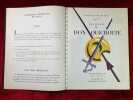
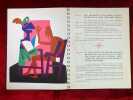




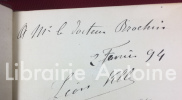
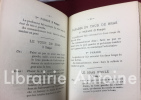



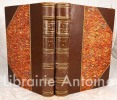
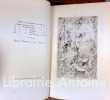


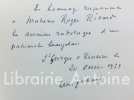





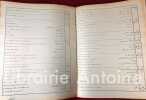



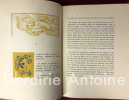

![Catalogue Nicolas. Liste des grands vins 1932. Illustrations de Edy Legrand.. [NICOLAS]. EDY LEGRAND (pseudonyme de Édouard Léon Louis Warschawsky)](https://static.livre-rare-book.com/pictures/GUH/3767_1_thumb.jpg)
![Catalogue Nicolas. Liste des grands vins 1932. Illustrations de Edy Legrand.. [NICOLAS]. EDY LEGRAND (pseudonyme de Édouard Léon Louis Warschawsky)](https://static.livre-rare-book.com/pictures/GUH/3767_2_thumb.jpg)
![Catalogue Nicolas. Liste des grands vins 1932. Illustrations de Edy Legrand.. [NICOLAS]. EDY LEGRAND (pseudonyme de Édouard Léon Louis Warschawsky)](https://static.livre-rare-book.com/pictures/GUH/3767_3_thumb.jpg)

